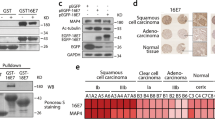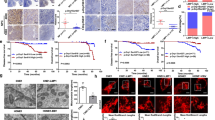Abstract
Epstein–Barr virus (EBV) infection is closely associated with nasopharyngeal carcinoma (NPC) and can be detected in early premalignant lesions of nasopharyngeal epithelium. The latent membrane protein 1 (LMP1) is an oncoprotein encoded by the EBV and is believed to play a role in transforming premalignant nasopharyngeal epithelial cells into cancer cells. RASSF1A is a tumor-suppressor gene commonly inactivated in many types of human cancer including NPC. In this study, we report a novel function of LMP1, in down-regulating RASSF1A expression in human epithelial cells. Downregulation of RASSF1A expression by LMP1 is dependent on the activation of intracellular signaling of NF-κB involving the C-terminal activating regions (CTARs) of LMP1. LMP1 expression also suppresses the transcriptional activity of the RASSF1A core promoter. RASSF1A stabilizes microtubules and regulates mitotic events. Aberrant mitotic spindles and chromosome aberrations are reported phenotypes in RASSF1A inactivated cells. In this study, we observed that LMP1 expression in human epithelial cells could induce aberrant mitotic spindles, disorganized interphase microtubules and aneuploidy. LMP1 expression could also suppress microtubule dynamics as exemplified by tracking movements of the growing tips of microtubules in live cells by transfecting EGFP-tagged EB1 into cells. The aberrant mitotic spindles and interphase microtubule organization induced by LMP1 could be rescued by transfecting RASSF1A expression plasmid into cells. Downregulation of RASSF1A expression by LMP1 may facilitate its role in transformation of premalignant nasopharyngeal epithelial cells into cancer cells.
This is a preview of subscription content, access via your institution
Access options
Subscribe to this journal
Receive 50 print issues and online access
$259.00 per year
only $5.18 per issue
Buy this article
- Purchase on Springer Link
- Instant access to full article PDF
Prices may be subject to local taxes which are calculated during checkout





Similar content being viewed by others
References
Balsitis S, Dick F, Lee D, Farrell L, Hyde RK, Griep AE et al. (2005). Examination of the pRb-dependent and pRb-independent functions of E7 in vivo. J Virol 79: 11392–11402.
Boukamp P, Popp S, Altmeyer S, Hulsen A, Fasching C, Cremer T et al. (1997). Sustained non-tumorigenic phenotype correlates with a largely stable chromosome content during long-term culture of the human keratinocyte line HaCaT. Genes Chromosomes Cancer 19: 201–214.
Cheung ST, Leung SF, Lo KW, Chiu KW, Tam JS, Fok TF et al. (1998). Specific latent membrane protein 1 gene sequences in type 1 and type 2 Epstein–Barr virus from nasopharyngeal carcinoma in Hong Kong. Int J Cancer 76: 399–406.
Chow LS, Lam CW, Chan SY, Tsao SW, To KF, Tong SF et al. (2006). Identification of RASSF1A modulated genes in nasopharyngeal carcinoma. Oncogene 25: 310–316.
Chow LS, Lo KW, Kwong J, To KF, Tsang KS, Lam CW et al. (2004). RASSF1A is a target tumor suppressor from 3p21.3 in nasopharyngeal carcinoma. Int J Cancer 109: 839–847.
Dammann R, Takahashi T, Pfeifer GP . (2001). The CpG island of the novel tumor suppressor gene RASSF1A is intensely methylated in primary small cell lung carcinomas. Oncogene 20: 3563–3567.
De Luca A, Baldi A, Esposito V, Howard CM, Bagella L, Rizzo PF et al. (1997). The retinoblastoma gene family pRb/p105, p107, pRb2/p130 and simian virus-40 large T-antigen in human mesotheliomas. Nat Med 3: 913–916.
Doxsey S . (2001). Re-evaluating centrosome function. Nat Rev Mol Cell Biol 2: 688–698.
Doxsey SJ, Stein P, Evans L, Calarco PD, Kirschner M . (1994). Pericentrin, a highly conserved centrosome protein involved in microtubule organization. Cell 76: 639–650.
Duensing S, Munger K . (2002). The human papillomavirus type 16 E6 and E7 oncoproteins independently induce numerical and structural chromosome instability. Cancer Res 62: 7075–7082.
Eliopoulos AG, Blake SM, Floettmann JE, Rowe M, Young LS . (1999a). Epstein–Barr virus-encoded latent membrane protein 1 activates the JNK pathway through its extreme C terminus via a mechanism involving TRADD and TRAF2. J Virol 73: 1023–1035.
Eliopoulos AG, Gallagher NJ, Blake SM, Dawson CW, Young LS . (1999b). Activation of the p38 mitogen-activated protein kinase pathway by Epstein–Barr virus-encoded latent membrane protein 1 coregulates interleukin-6 and interleukin-8 production. J Biol Chem 274: 16085–16096.
Eliopoulos AG, Young LS . (2001). LMP1 structure and signal transduction. Semin Cancer Biol 11: 435–444.
Huang DP, Ho JH, Poon YF, Chew EC, Saw D, Lui M et al. (1980). Establishment of a cell line (NPC/HK1) from a differentiated squamous carcinoma of the nasopharynx. Int J Cancer 26: 127–132.
Jin DY, Giordano V, Kibler KV, Nakano H, Jeang KT . (1999). Role of adapter function in oncoprotein-mediated activation of NF-kappaB. Human T-cell leukemia virus type I Tax interacts directly with IkappaB kinase gamma. J Biol Chem 274: 17402–17405.
Kang GH, Lee S, Kim WH, Lee HW, Kim JC, Rhyu MG et al. (2002). Epstein–Barr virus-positive gastric carcinoma demonstrates frequent aberrant methylation of multiple genes and constitutes CpG island methylator phenotype-positive gastric carcinoma. Am J Pathol 160: 787–794.
Karsenti E, Vernos I . (2001). The mitotic spindle: a self-made machine. Science 294: 543–547.
Li HM, Man C, Jin Y, Deng W, Yip YL, Feng HC et al. (2006). Molecular and cytogenetic changes involved in the immortalization of nasopharyngeal epithelial cells by telomerase. Int J Cancer 119: 1567–1576.
Li HM, Zhuang ZH, Wang Q, Pang JC, Wang XH, Wong HL et al. (2004). Epstein–Barr virus latent membrane protein 1 (LMP1) upregulates Id1 expression in nasopharyngeal epithelial cells. Oncogene 25: 4488–4494.
Liu L, Tommasi S, Lee DH, Dammann R, Pfeifer GP . (2003). Control of microtubule stability by the RASSF1A tumor suppressor. Oncogene 22: 8125–8136.
Liu MT, Chen YR, Chen SC, Hu CY, Lin CS, Chang YT et al. (2004). Epstein–Barr virus latent membrane protein 1 induces micronucleus formation, represses DNA repair and enhances sensitivity to DNA-damaging agents in human epithelial cells. Oncogene 23: 2531–2539.
Lo AK, Huang DP, Lo KW, Chui YL, Li HM, Pang JC et al. (2004a). Phenotypic alterations induced by the Hong Kong-prevalent Epstein–Barr virus-encoded LMP1 variant (2117-LMP1) in nasopharyngeal epithelial cells. Int J Cancer 109: 919–925.
Lo AK, Liu Y, Wang XH, Huang DP, Yuen PW, Wong YC et al. (2003). Alterations of biologic properties and gene expression in nasopharyngeal epithelial cells by the Epstein–Barr virus-encoded latent membrane protein 1. Lab Invest 83: 697–709.
Lo KW, Huang DP . (2002). Genetic and epigenetic changes in nasopharyngeal carcinoma. Semin Cancer Biol 12: 451–462.
Lo KW, To KF, Huang DP . (2004b). Focus on nasopharyngeal carcinoma. Cancer Cell 5: 423–428.
Mathe E . (2004). RASSF1A, the new guardian of mitosis. Nat Genet 36: 117–118.
Patel D, Incassati A, Wang N, McCance DJ . (2004). Human papillomavirus type 16 E6 and E7 cause polyploidy in human keratinocytes and up-regulation of G2-M-phase proteins. Cancer Res 64: 1299–1306.
Pathmanathan R, Prasad U, Sadler R, Flynn K, Raab-Traub N . (1995). Clonal proliferations of cells infected with Epstein–Barr virus in preinvasive lesions related to nasopharyngeal carcinoma. N Engl J Med 333: 693–698.
Rong R, Jin W, Zhang J, Sheikh MS, Huang Y . (2004). Tumor suppressor RASSF1A is a microtubule-binding protein that stabilizes microtubules and induces G2/M arrest. Oncogene 23: 8216–8230.
Rosa J, Canovas P, Islam A, Altieri DC, Doxsey SJ . (2006). Survivin modulates microtubule dynamics and nucleation throughout the cell cycle. Mol Biol Cell 17: 1483–1493.
Song MS, Song SJ, Ayad NG, Chang JS, Lee JH, Hong HK et al. (2004). The tumour suppressor RASSF1A regulates mitosis by inhibiting the APC-Cdc20 complex. Nat Cell Biol 6: 129–137.
Tsao SW, Tramoutanis G, Dawson CW, Lo AK, Huang DP . (2002a). The significance of LMP1 expression in nasopharyngeal carcinoma. Semin Cancer Biol 12: 473–487.
Tsao SW, Wang X, Liu Y, Cheung YC, Feng H, Zheng Z et al. (2002b). Establishment of two immortalized nasopharyngeal epithelial cell lines using SV40 large T and HPV16E6/E7 viral oncogenes. Biochim Biophys Acta 1590: 150–158.
Vos MD, Martinez A, Elam C, Dallol A, Taylor BJ, Latif F et al. (2004). A role for the RASSFIA tumor suppressor in the regulation of tubulin polymerization and genomic stability. Cancer Res 12: 4112–4116.
Wang D, Liebowitz D, Kieff E . (1985). An EBV membrane protein expressed in immortalized lymphocytes transforms established rodent cells. Cell 43: 831–840.
Wu L, Nakano H, Wu Z . (2006). The C-terminal activating region 2 of the Epstein–Barr virus-encoded latent membrane protein 1 activates NF-kappaB through TRAF6 and TAK1. J Biol Chem 281: 2162–2169.
Yu J, Ni M, Xu J, Zhang H, Gao B, Gu J et al. (2002). Methylation profiling of twenty promoter-CpG islands of genes which may contribute to hepatocellular carcinogenesis. BMC Cancer 2: 29–35.
Zhang H, Tsao SW, Jin C, Strombeck B, Yuen PW, Kwong YL et al. (2004). Sequential cytogenetic and molecular cytogenetic characterization of an SV40T-immortalized nasopharyngeal cell line transformed by Epstein–Barr virus latent membrane protein-1 gene. Cancer Genet Cytogen 150: 144–152.
Acknowledgements
This project was supported by the research Grant council, Hong Kong (Grant numbers: HKU7356/02M, N_HKU728/04, HKU7 and CRCG 10205784). We also acknowledged the support from the Core Imaging Facility of the Li Ka Shing Faculty of Medicine, University of Hong Kong for the live cell imaging study.
Author information
Authors and Affiliations
Corresponding author
Additional information
Supplementary Information accompanies the paper on the Oncogene website (http://www.nature.com/onc).
Rights and permissions
About this article
Cite this article
Man, C., Rosa, J., Lee, L. et al. Latent membrane protein 1 suppresses RASSF1A expression, disrupts microtubule structures and induces chromosomal aberrations in human epithelial cells. Oncogene 26, 3069–3080 (2007). https://doi.org/10.1038/sj.onc.1210106
Received:
Revised:
Accepted:
Published:
Issue Date:
DOI: https://doi.org/10.1038/sj.onc.1210106
Keywords
This article is cited by
-
Correlation Between β-Catenin Expression and Staging in Nasopharyngeal Carcinoma Patients
Indian Journal of Otolaryngology and Head & Neck Surgery (2019)



